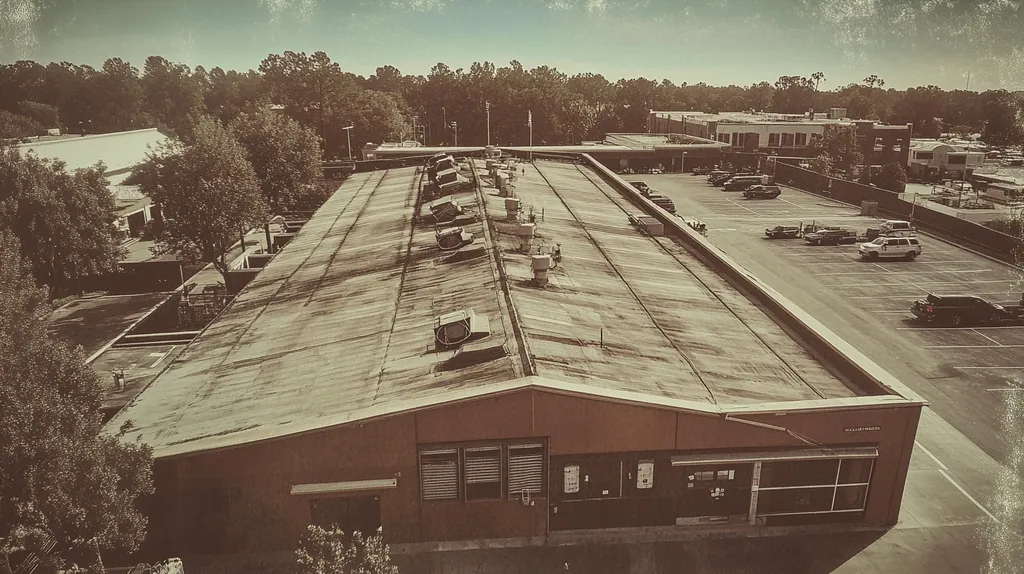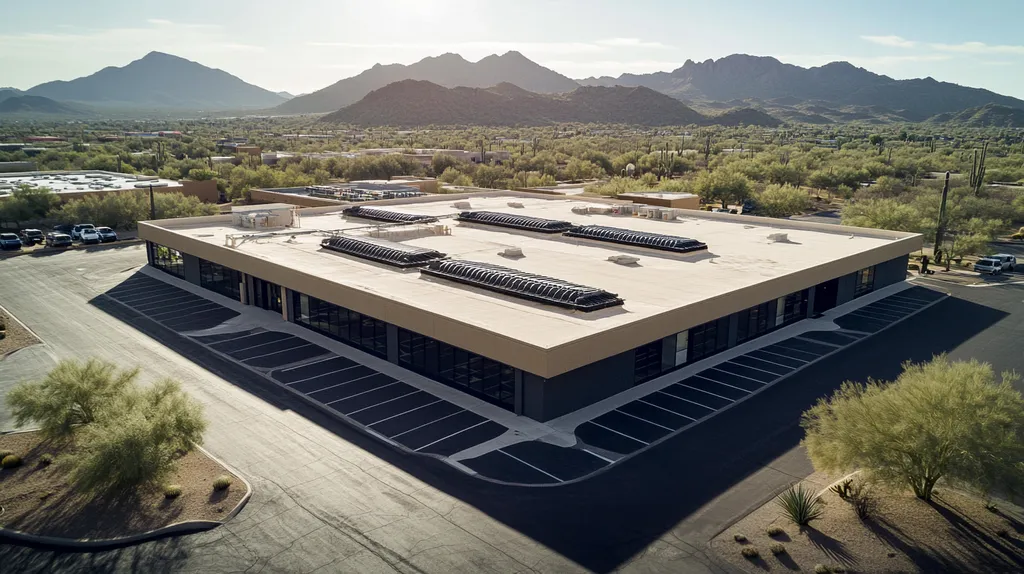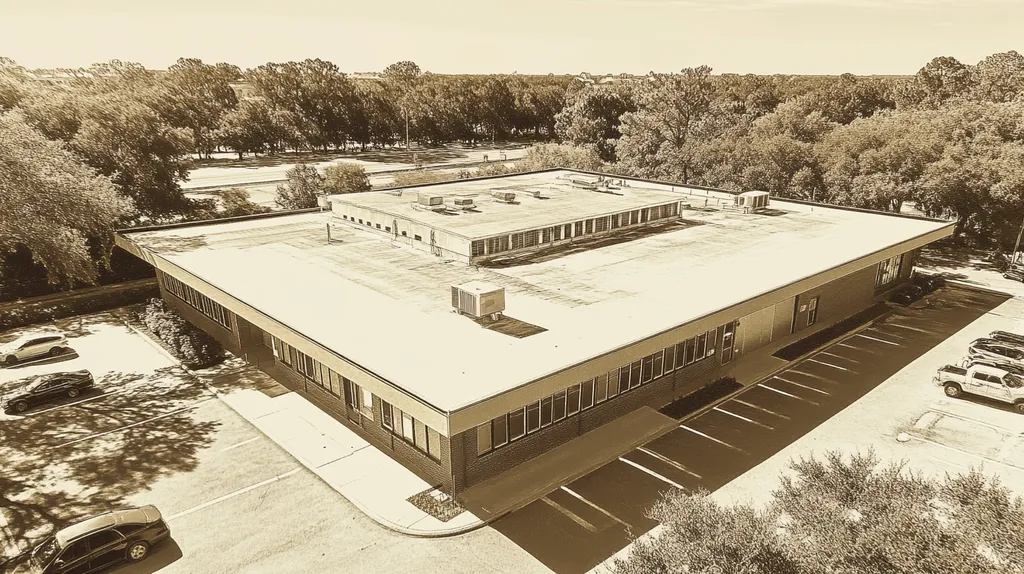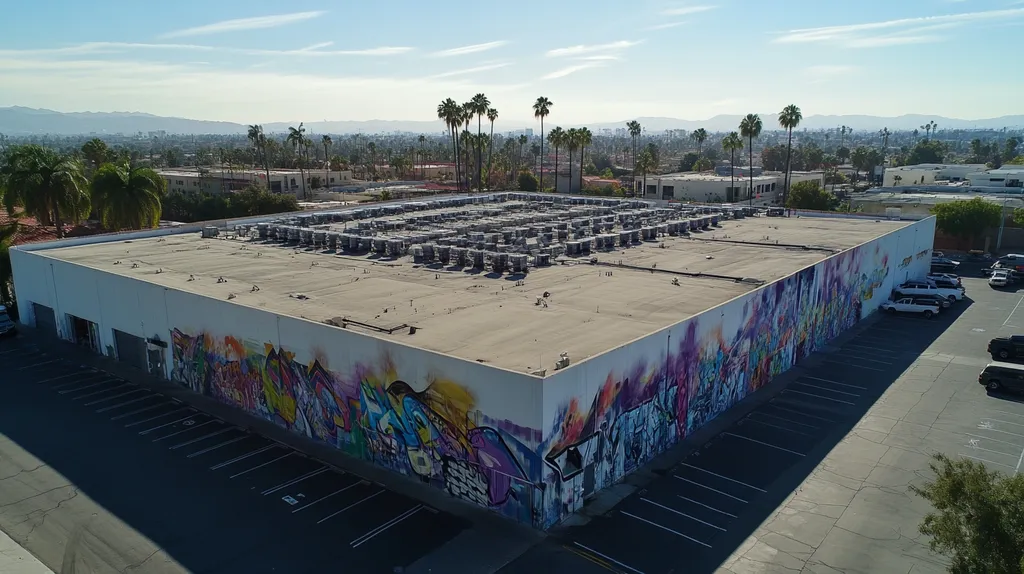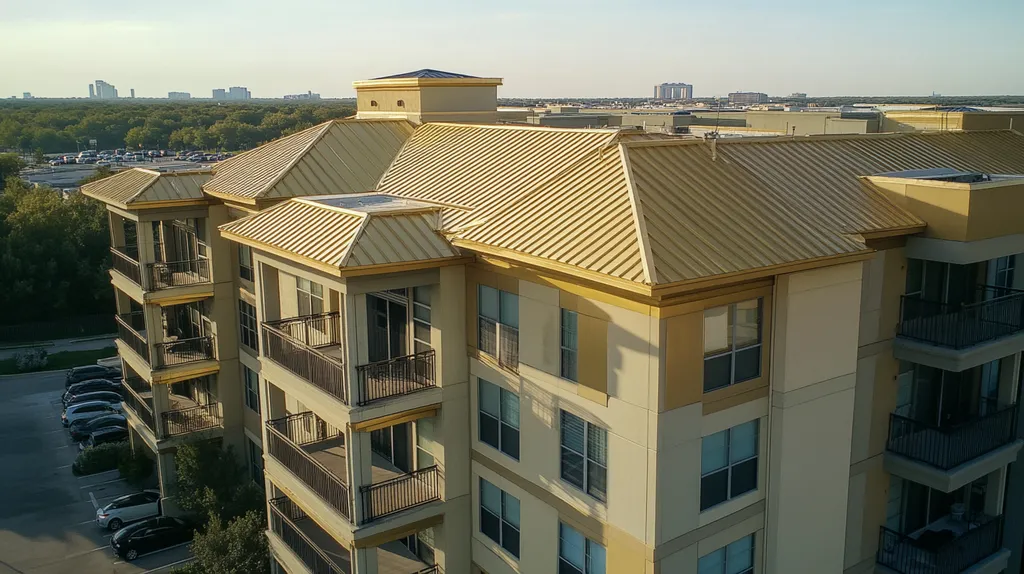The commercial roofing industry generates over 15 million tons of waste annually, with less than 15% currently being recycled – a staggering inefficiency that costs property owners millions while damaging the environment.
Despite growing pressure for sustainable practices, established disposal methods continue to prioritize landfilling over recycling, creating mounting challenges for facility managers and contractors alike.
This analysis examines the systemic barriers, missed opportunities, and data-driven solutions that could transform commercial roof recycling from an afterthought into an industry standard.
SECTION 1: CURRENT PRACTICES
As commercial roofing systems reach their end-of-life, improper disposal methods contribute to serious environmental challenges and economic losses. The Environmental Protection Agency (EPA) reports that the United States generates approximately 15 million tons of roofing waste annually. Yet, many contractors continue to rely on mixed waste disposal, limiting recycling opportunities and intensifying landfill overpopulation. This section delves into the inefficiencies of current disposal practices, the role of contractors, and the predominant focus on asphalt shingle recycling.
Mixed Waste Disposal Methods
Mixed waste disposal remains the leading method utilized by numerous commercial roofing contractors. This approach entails combining a variety of materials—such as metal, insulation, and shingles—into a single waste stream. The result is a considerable loss of potentially recyclable materials, which could have been processed and repurposed.
Many roofing professionals either lack awareness of or access to facilities capable of sorting and recycling these materials efficiently. As a consequence, valuable resources end up in landfills, compounding the waste crisis. This oversight is both financially detrimental and environmentally irresponsible.
Moreover, local regulations can complicate disposal tasks further. Many municipalities impose stringent waste disposal guidelines, often pushing contractors toward mixed methods instead of specialized recycling options. Consequently, some professionals perceive recycling as an inconvenient chore, opting for the path of least resistance when it comes to disposal.
In conclusion, the heavy reliance on mixed waste disposal is an urgent concern that escalates environmental degradation. Tackling this issue hinges on recognizing the availability and importance of distinct recycling options.
Limited Contractor Involvement
Contractor participation in recycling initiatives is often minimal, frequently stemming from a lack of awareness or motivation. Many commercial roofers still have not embraced recycling as part of their business models. This shortfall translates into lost opportunities for adopting sustainable practices and enhancing revenue streams.
Some professionals prioritize swift project completion and profit margins over environmentally responsible strategies. As a result, recycling becomes an ancillary consideration in their service offerings. This can establish a vicious cycle where recycling is undervalued within the industry.
Adding to the complexity, few incentives exist for contractors to implement recycling programs. While certain regions provide financial rebates for recycling efforts, such incentives are inconsistent across the board. This variability prompts many roofers to dismiss recycling as an impractical option, undermining the effectiveness of the industry as a whole.
To prompt a shift in this mindset, industry-wide collaboration is essential. Implementing training sessions and awareness campaigns that highlight both the financial and environmental benefits of recycling can mobilize contractors. Progress hinges on increased involvement from the roofing community in transforming disposal methodologies.
Dominance of Asphalt Shingle Recycling
Asphalt shingles dominate the materials used in commercial roofing, leading to a disproportionate focus on recycling these products. While successful asphalt shingle recycling initiatives are in place, they often overshadow other roofing components that also need attention, such as metals and insulation.
Recycling asphalt shingles lowers the demand for new raw materials, yet it does not address the broader issue of other materials contributing to waste streams. Thus, while these programs are valuable, they only partially remedy the waste conundrum within commercial roofing.
This industry emphasis on asphalt shingle recycling can foster a misleading sense of achievement. Property owners might believe that recycling shingles fulfills their environmental responsibilities, neglecting the other materials destined for landfills.
A more inclusive recycling framework that considers all roofing materials is imperative. Acknowledging the full array of materials involved in commercial roofing can significantly enhance waste reduction efforts. Transformative change requires a holistic perspective on recycling in the roofing sector.
SECTION 2: SYSTEMIC ISSUES
The commercial roofing industry grapples with critical systemic issues that hinder the evolution of roof recycling practices. With over 11 million tons of roofing materials finding their way to landfills each year, the implications for property owners are significant. Inefficient disposal methods not only squander valuable resources but also have detrimental effects on the environment. Addressing these systemic challenges is paramount for the industry to embrace a sustainable future. Key issues include a lack of standardized protocols, inadequate training, and persisting regulatory barriers.
Lack of Standardized Protocols
The absence of standardized protocols for commercial roof recycling generates confusion and inefficiencies throughout the industry. Without clear, universally applied guidelines, roofing contractors often employ varying methods in the dismantling and processing of roofing materials. This inconsistency not only complicates recycling efforts but can also result in significant volumes of debris accumulating in landfills.
Many property owners are left unaware of the recycling options available to them. In the absence of standard practices, facility managers struggle to make informed decisions regarding the recycling of their old roofs. The introduction of universally accepted protocols could streamline recycling processes, making them more efficient and accessible.
Additionally, implementing standard protocols would enhance data collection about recycling practices. Currently, statistics regarding roof recycling initiatives are frequently inaccurate or insufficient. A consistent approach would illuminate industry performance and drive necessary improvements.
In summary, the lack of standardized protocols contributes to wasted materials and stifles potential recycling opportunities. Establishing clear guidelines is a vital first step toward a more effective recycling framework.
Inadequate Training and Education
A notable barrier to effective roof recycling lies in the inadequate training and education available within the industry. Many roofing professionals lack comprehensive knowledge of the benefits and techniques for recycling materials. This knowledge gap results in a hesitance to embrace new practices, ultimately impeding progress within the industry.
Current education programs frequently focus on installation and maintenance rather than emphasizing recycling solutions. This oversight leaves both facility managers and property owners uninformed about their options, making informed recycling decisions increasingly troublesome. Introducing training sessions that prioritize sustainability could lead to a wider adoption of recycling practices.
Moreover, ongoing educational resources are sparse within the industry. Many roofing companies do not provide their employees with updates or advancements in recycling best practices. By integrating recycling education into training curriculums, companies can better equip their workers to implement environmentally responsible solutions.
In conclusion, enhancing training and educational resources surrounding roof recycling is essential for advancing the industry. An informed workforce is better positioned to adopt sustainable approaches and assist property owners in making superior choices.
Regulatory and Logistical Barriers
Regulatory and logistical barriers pose considerable challenges to commercial roof recycling initiatives. Existing regulations regarding waste management can often make recycling a cumbersome undertaking for contractors. In some regions, local laws even discourage recycling by imposing steep fees or logistical hurdles.
This regulatory inconsistency can confuse property owners, as laws tend to differ significantly between jurisdictions. These variations can deter companies from pursuing recycling options. Establishing a unified set of regulations would facilitate smoother transitions into recycling practices.
Logistical challenges also complicate recycling efforts. The transport of heavy, bulky roofing materials can be both costly and labor-intensive, particularly if recycling facilities aren’t conveniently located. Improving the infrastructure for the collection and processing of these materials is crucial to support widespread recycling initiatives.
In summary, the interplay of regulatory and logistical barriers distinctly limits the effectiveness of roof recycling efforts. Advocacy for more supportive regulations and improvements in logistics could pave the way for more sustainable practices within the industry.
SECTION 3: MISSED OPPORTUNITIES
The commercial roofing industry faces a critical challenge in waste management. With approximately 11 million tons of roofing material discarded in landfills each year, the environmental impact is significant. As property owners and facility managers increasingly seek sustainable alternatives, it becomes essential to tap into the recycling potential of roofing materials. This section explores the overlooked materials, the economic benefits of recycling, and the adverse environmental effects of traditional landfill practices.
Untapped Potential of Other Materials
Many roofing systems incorporate a diverse range of materials that are often underutilized in recycling efforts. While asphalt shingles constitute a significant portion of roofing waste, only a small percentage is recycled. Instead of allowing these valuable materials to go to waste, they can be repurposed into asphalt for roads or for use in new roofing systems.
Metals such as aluminum and steel also present substantial recyclable opportunities. Their high scrap value provides motivation for facility managers to invest in robust recycling programs that reduce waste while generating revenue. The exploration of these recycling avenues can lead to responsible resource management in the industry.
Raising awareness of the various recyclable components within roofing systems can usher in innovative practices that maximize resource recovery. A shift in perspective regarding the end-of-life management of roofing materials holds the potential to transform industry waste practices for the better.
Ultimately, the recycling potential extends beyond traditional frameworks, presenting a critical opportunity for innovation. Embracing all recyclable materials can reshape waste management strategies in commercial roofing.
Economic Benefits of Recycling
The financial advantages of recycling roofing materials are considerable yet often overlooked. Research indicates that property owners can realize savings through reduced disposal fees when opting to recycle rather than relegating materials to landfills. This shift allows for better budget management in roofing projects.
In addition, various states offer rebates and incentives for recycling initiatives, assisting in defraying the costs related to installing sustainable roofing systems. By capitalizing on these programs, property owners not only contribute to environmental preservation but also bolster their financial health.
The long-term economic benefits are even more pronounced when assessing the lifecycle costs of materials. Roofs designed using recyclable materials typically incur lower maintenance and replacement expenses. Investing in recyclable roofing now can yield substantial financial benefits over the lifespan of a building.
In summary, the economic advantages of recycling roofing materials extend well beyond initial savings. With the right strategies, property owners can secure a more sustainable financial outlook in their operations.
Environmental Impact of Landfilling
The environmental consequences of disposing roofing materials in landfills are dire. Each year, the practice contributes to the depletion of natural resources and heightens carbon emissions. Such actions run counter to the global movement toward sustainability.
As landfill space dwindles, the growing volume of roofing waste exacerbates environmental issues. Toxic substances from roofing materials can leach into the soil and waterways, posing risks to local ecosystems and surrounding communities. Embracing proactive recycling measures can significantly reduce these threats.
Moreover, recycling roofing materials presents an essential opportunity to cut down the industry’s overall carbon footprint. The energy savings from recycling processes, compared to the energy-intensive task of manufacturing new materials, are monumental. Each ton of recycled material can save as much as 2,500 pounds of carbon dioxide emissions.
The urgent need for environmentally responsible approaches in commercial roofing highlights the importance of addressing waste management practices. By making informed decisions, property owners can contribute to a more sustainable future.
SECTION 4: ROOT CAUSES
The pressing need for commercial roof recycling stems from a staggering waste generation problem. Annually, around 11 million tons of roofing material are discarded into landfills, causing significant harm to the environment. To address this issue effectively, it is essential to understand the root causes of this waste crisis. Historical disposal practices, insufficient government incentives, and industry resistance form substantial barriers to the implementation of recycling and sustainable practices in roofing. By confronting these underlying factors, stakeholders can move toward a more environmentally conscious future.
Historical Disposal Practices
For decades, roofing waste has been viewed predominantly as a nuisance rather than a resource. The prevailing tradition of sending materials to landfills has perpetuated a mindset that hinders recycling initiatives within the industry. This mentality has fostered a cycle where waste is routinely discarded, overlooking the potential value of recycling.
Historically, roofing contractors prioritized rapid disposal over sustainable practices. The emphasis on immediate solutions often led to the careless handling of recyclable materials, which were easier to throw away than to sort and process. As a result, valuable resources that could have been reclaimed are lost forever.
Moreover, as landfill costs rise, communities face mounting pressure regarding waste management. The accumulation of roofing waste in landfills imposes significant financial burdens on municipalities. In light of these increasing costs, there is a critical need to reassess disposal practices. However, long-standing habits within the industry are deeply entrenched, making change challenging.
Transforming this situation requires a shift in perspective throughout the industry. Promoting recycling as a practical and beneficial option could redefine how roofing waste is treated, leading to both environmental conservation and economic advantages.
Insufficient Government Incentives
Government initiatives significantly influence the success of recycling programs, yet many existing efforts are insufficient. Numerous state and local recycling programs offer limited financial support to encourage roofing contractors to incorporate recycling into their operations. Without proper incentives, many contractors see minimal motivation to alter their waste management practices.
The lack of meaningful policies restricts the implementation of effective recycling measures. For instance, the absence of tax deductions or grants to alleviate recycling costs often leads contractors to opt for simpler disposal methods that contribute to landfill waste. When sustainable practices go unrewarded, it discourages their adoption.
Additionally, current regulations frequently fail to address the specific challenges presented by roofing waste. This oversight leaves contractors uncertain about compliance requirements and often reluctant to embrace recycling initiatives. Establishing clear, comprehensive guidelines and incentives could dramatically shift the recycling landscape in the roofing industry.
Enhancing government support by developing robust incentives can stimulate significant changes in industry behavior. By creating a regulatory framework that encourages recycling, stakeholders are more likely to commit to sustainable practices and lighten their environmental footprint.
Industry Resistance to Change
Resistance to change is a pervasive issue in the roofing industry, stalling advancements in recycling practices. Many contractors hesitate to adopt recycling due to perceived costs and anticipated labor challenges. Concerns regarding additional expenses often overshadow the long-term financial savings associated with responsible waste management.
This hesitance is further compounded by a lack of awareness about available recycling technologies and methods. Many contractors remain uninformed about the options at their disposal, which perpetuates confusion and keeps outdated practices in place.
The established relationships within the roofing sector and traditional routines further amplify resistance to change. Concerns about disrupting successful business models can deter innovation and the exploration of alternative practices. Consequently, immediate recycling options are often overlooked or undervalued.
To break this cycle of inertia, industry leaders must advocate for education and training initiatives that showcase the value of recycling. By sharing success stories and practical examples, the roofing sector can begin to shift its culture toward more sustainable practices and solutions.
DATA DRIVEN EVIDENCE
Commercial roofing waste represents a significant yet often overlooked issue contributing to landfill overflow, with an estimated 11 million tons discarded annually across the United States. Current disposal practices primarily favor landfills, disregarding the substantial benefits that recycling can offer. Through data-driven strategies, the roofing industry can foster sustainable solutions that enhance economic performance while mitigating environmental damage. This section illuminates crucial statistics, highlights successful case studies, and presents important economic and ecological metrics that emphasize the urgent need for transformation.
Quantifying Waste and Recycling Rates
In the U.S., commercial roofing generates around 13 million tons of waste each year, with approximately 80% finding its way into landfills while only about 15% is recycled. These figures starkly underscore the inefficiencies inherent in current waste management practices. By adopting proactive roof recycling approaches, property owners can not only significantly minimize waste but also enhance community sustainability efforts.
For instance, the National Roofing Contractors Association (NRCA) reports that implementing recycling methods can divert as much as 95% of roofing waste from landfills. This statistic highlights the untapped potential for transformative change in waste management. Moreover, the impending enforcement of stricter landfill regulations emphasizes the necessity for property managers to engage in roof recycling practices.
Understanding these metrics is vital for property owners. Embracing recycling not only reduces waste but also leads to lower disposal costs. By aligning operational goals with recycling initiatives, businesses can position themselves as responsible environmental stewards, enhancing their brand reputation among sustainability-conscious clients.
Case Studies in Successful Recycling
Several compelling case studies demonstrate the effectiveness of commercial roof recycling initiatives. A well-known retail chain implemented a comprehensive recycling program across its locations and partnered with local recycling facilities. This strategic collaboration successfully diverted over 1,700 tons of roofing materials from landfills in a single year.
This program not only reduced the environmental footprint of the company but also resulted in savings of approximately $120,000 in disposal fees. Such financial advantages highlight the significant economic benefits associated with proactive recycling practices.
Additionally, a university in the Midwest launched a roof recycling initiative during a recent renovation, achieving a remarkable recycling rate of over 90% of the old roofing materials. This initiative not only lowered operational costs but also established a model for future projects on its campus.
Economic and Environmental Metrics
The economic advantages of adopting roof recycling practices are compelling. A study conducted by the EPA found that building owners who embrace recycling initiatives can achieve a return on investment as high as 300%. This statistic illustrates the financial viability of environmentally responsible decision-making.
From an environmental perspective, recycling roofing materials plays a key role in curbing greenhouse gas emissions. By diverting waste from landfills, each ton of reused material can prevent over 1.2 tons of CO2 from entering the atmosphere. This reduction is not merely statistical; it has substantial implications for global climate change mitigation efforts.
Furthermore, the long-term benefits of engaging in recycling can enhance a company’s standing with customers and regulatory agencies alike. As environmental regulations become increasingly stringent, proactively implementing roofing recycling practices will likely be essential for compliance and demonstrating corporate responsibility.
SECTION 6: ALTERNATIVE SOLUTIONS
As pressure mounts to mitigate landfill waste, it becomes crucial for the roofing industry to adopt smarter disposal strategies. Currently, over 13 million tons of commercial roofing waste find their way into landfills each year, resulting in substantial environmental harm. By exploring alternative solutions, such as on-site sorting, integrated recycling programs, and innovative repurposing of materials, property owners and facility managers can help reduce waste significantly.
On-Site Sorting and Source Separation
On-site sorting and source separation are vital strategies for improving the recycling rates of roofing materials. By categorizing materials like asphalt, metal, and insulation directly at the job site, contractors can ensure that more waste is recycled rather than being sent to landfills. This immediate action not only conserves resources but can also lead to lower disposal costs for property owners.
Additionally, on-site sorting helps contractors gain a clearer insight into the recyclable content of their projects. When materials are separated early, they can be efficiently routed to suitable recycling facilities, maximizing the volume of material that is repurposed. This proactive approach aligns perfectly with sustainable practices, minimizing the need for new raw materials and enriching the overall waste management strategy.
Many commercial properties have already begun implementing this strategy, significantly reducing waste generated during roof installations and replacements. By prioritizing sorting, these companies contribute to a circular economy that benefits both the environment and their operational budgets.
Investing in training programs that equip employees with effective sorting techniques can ease this transition. With proper training and resources, contractors can streamline the sorting process, thus further enhancing recycling rates across their projects.
Integrated Recycling Programs for Contractors
Integrated recycling programs present a compelling solution to the challenges posed by roofing waste. These programs foster partnerships between roofing contractors and recycling facilities, facilitating efficient collection and processing of roofing materials. Collaboration ensures that valuable materials can be effectively diverted from landfills.
These initiatives pave the way for establishing a dedicated recycling infrastructure tailored to the roofing industry. This collaboration not only supports contractors in reaching their sustainability objectives but also provides facility managers with clear frameworks for responsibly addressing roofing waste. Reliable channels for recycling make these transitions smoother and more effective.
Successful integrated recycling programs often include incentives designed to encourage contractors who engage in recycling. Financial rewards or discounts with recycling partners can motivate contractors to adopt sustainable practices while remaining budget-conscious.
Participating in established recycling programs also allows construction firms to demonstrate their commitment to sustainability. Such engagement resonates with clients and stakeholders, enhancing corporate reputation while making significant strides in ecological responsibility.
Innovative Uses for Recycled Materials
The innovative use of recycled materials is reshaping the roofing industry’s approach to waste management. Recycled roofing materials can be converted into new products, such as asphalt pavement or insulation, thus reducing reliance on virgin resources. This ongoing innovation presents numerous sustainable material options for future projects.
For instance, some companies are now producing roof tiles from recycled rubber or plastics, which not only provide durability but also lessen environmental impacts. Similarly, asphalt shingles are being increasingly recycled, helping to close the loop on roofing materials.
Using recycled materials can also lead to cost-effective alternatives for property owners without compromising quality. The competitive edge offered by environmentally friendly products is becoming increasingly recognized, appealing to clients who prioritize sustainability.
Encouraging the innovative application of recycled materials fosters a culture of sustainability within the roofing industry. As these practices gain traction, they are likely to inspire further advancements in material science, driving more effective recycling methods and novel applications for repurposed materials.
Moving Forward
The commercial roofing industry stands at a critical crossroads, with over 11 million tons of recyclable materials needlessly entering landfills each year at an estimated cost of $1.2 billion to property owners.
Without immediate intervention to address systemic barriers and outdated practices, this waste will continue to inflate operational costs while causing irreversible environmental damage.
The data clearly demonstrates that implementing standardized recycling protocols, enhancing contractor training, and leveraging innovative material applications can reduce waste by up to 95% while generating significant cost savings.
As regulatory pressures mount and landfill fees escalate, property owners and facility managers who embrace comprehensive recycling programs will be best positioned to thrive in an increasingly sustainability-focused marketplace.
FREQUENTLY ASKED QUESTIONS
Q. What are the current commercial roof disposal practices?
A. Many contractors utilize mixed waste disposal methods, combining various materials into one stream. This approach often leads to valuable recyclable materials ending up in landfills, contributing to environmental challenges and economic losses. Recognizing distinct recycling options is essential to enhance sustainability in the roofing sector.
Q. How do systemic issues affect industrial roof recycling?
A. Systemic issues such as a lack of standardized protocols and inadequate training contribute to inefficient recycling efforts. Additionally, regulatory and logistical barriers create confusion and deter contractors from adopting sustainable practices. Addressing these challenges is crucial for improving recycling initiatives within the commercial roofing industry.
Q. What missed opportunities exist in commercial roof recycling?
A. Significant opportunities are often overlooked in terms of untapped materials. Many recyclable roofing components, such as metals and insulation, are neglected in recycling initiatives, leading to lost economic benefits. Recognizing and utilizing these materials can significantly enhance sustainability efforts and reduce environmental impact.
Q. What root causes hinder commercial roof recycling?
A. Historical disposal practices and insufficient government incentives contribute to significant challenges in recycling efforts. Many contractors continue to rely on traditional disposal methods due to a lack of motivation and awareness regarding sustainable practices. Addressing these root causes is essential for fostering industry-wide change.
Q. What data supports the need for better roofing material recycling?
A. Approximately 13 million tons of commercial roofing waste are generated annually in the U.S. Of this, 80% heads to landfills, indicating significant room for improvement. Statistics reveal that adopting recycling initiatives can divert up to 95% of roofing waste, showcasing a clear path toward sustainability.
Q. What alternative solutions can enhance industrial roof recycling?
A. On-site sorting and integrated recycling programs offer significant improvements for recycling roofing materials. By establishing a clear separation of materials, contractors can boost recycling rates and reduce waste. Additionally, innovative uses for recycled materials help drive sustainable practices within the industry.
Q. How can facility managers encourage better recycling practices?
A. Facility managers can advocate for enhanced recycling by sourcing contractors who prioritize sustainability. Offering incentives for recycling initiatives and facilitating access to training programs can further improve practices. Sharing successful case studies and outcomes often motivates contractors to adopt more responsible waste management strategies.

